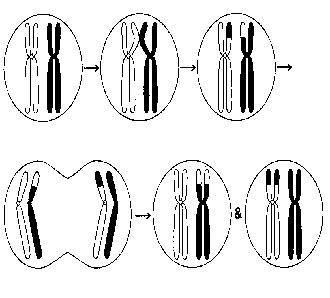


UNIPARENTAL DISOMY (UPD): A CONSEQUENCE
OF NON-DISJUNCTION AND THE IMPLICATIONS
IN PRENATAL DIAGNOSIS
Velissariou V*
*Corresponding Author: Dr. Voula Velissariou, Cytogenetics Laboratory, Department of Genetics and Molecular Biology, Mitera Hospital, Erythrou Stavrou 7, Maroussi, Athens 11523, Greece; Tel.: +30-210-686-9869; Fax: +30-210-689-9476; E-mail: voulavel@ hol.gr
page: 55
|
|
UNIPARENTAL DISOMY AND ABNORMAL PHENOTYPE
Uniparental disomy has been recognized for most chromosomes. For some, like chromosomes 3, 12, 13, 18, 19 and 21, there is no apparent phenotypic consequence (Fig. 2). For others, like chromosomes 2, 4, 5, 8, 9, and 10, there may be, and sporadic cases have been described [5]. For chromosomes 6, 7, 11, 14, 15, 16 and 20, it has been well documented that UPD causes abnormality (Table 2) [5,11]. Kalousek and Barrett [12]caution that a phenotypic defect may be due to an accompanying placental trisomy or undetected low-level mosaicism in the fetus rather than to the UPD itself. This might be a major reason for both normal and abnormal phenotypes in cases with UPD for the same chromosome.
Figure 1. The genesis of segmental UPD (of part of the short arm). In one cell of the early conceptus, the paternal and maternal homologues of a chromosome pair (a) undergo somatic recombination between the short arms (b, c). Segregation at mitosis (d) produces daughter cells with segmental UPD.

|
Term |
Mechanism of Formation |
|
Trisomy rescue |
A disomic gamete is fertilized by a monosomic gamete. The resulting trisomic zygote loses one chromosome in early mitotic division. In one-third of cases, UPD for that chromosome is the result. |
|
Mitotic duplication |
A monosomic gamete is fertilized by a nullisomic gamete. The monosomic chromosome is then duplicated in an early mitotic division. |
|
Postfertilization error |
A normal gamete is fertilized by a normal gamete. Then, in an early mitotic division, one homologous chromosome is lost, and subsequently, the one is duplicated or vice versa. |
|
Gamete complementation |
A disomic gamete is fertilized by a nullisomic gamete; UPD is already present in the zygote. |
Table 1. Formation of uniparental disomy.
|
|
|
|



 |
Number 27
VOL. 27 (2), 2024 |
Number 27
VOL. 27 (1), 2024 |
Number 26
Number 26 VOL. 26(2), 2023 All in one |
Number 26
VOL. 26(2), 2023 |
Number 26
VOL. 26, 2023 Supplement |
Number 26
VOL. 26(1), 2023 |
Number 25
VOL. 25(2), 2022 |
Number 25
VOL. 25 (1), 2022 |
Number 24
VOL. 24(2), 2021 |
Number 24
VOL. 24(1), 2021 |
Number 23
VOL. 23(2), 2020 |
Number 22
VOL. 22(2), 2019 |
Number 22
VOL. 22(1), 2019 |
Number 22
VOL. 22, 2019 Supplement |
Number 21
VOL. 21(2), 2018 |
Number 21
VOL. 21 (1), 2018 |
Number 21
VOL. 21, 2018 Supplement |
Number 20
VOL. 20 (2), 2017 |
Number 20
VOL. 20 (1), 2017 |
Number 19
VOL. 19 (2), 2016 |
Number 19
VOL. 19 (1), 2016 |
Number 18
VOL. 18 (2), 2015 |
Number 18
VOL. 18 (1), 2015 |
Number 17
VOL. 17 (2), 2014 |
Number 17
VOL. 17 (1), 2014 |
Number 16
VOL. 16 (2), 2013 |
Number 16
VOL. 16 (1), 2013 |
Number 15
VOL. 15 (2), 2012 |
Number 15
VOL. 15, 2012 Supplement |
Number 15
Vol. 15 (1), 2012 |
Number 14
14 - Vol. 14 (2), 2011 |
Number 14
The 9th Balkan Congress of Medical Genetics |
Number 14
14 - Vol. 14 (1), 2011 |
Number 13
Vol. 13 (2), 2010 |
Number 13
Vol.13 (1), 2010 |
Number 12
Vol.12 (2), 2009 |
Number 12
Vol.12 (1), 2009 |
Number 11
Vol.11 (2),2008 |
Number 11
Vol.11 (1),2008 |
Number 10
Vol.10 (2), 2007 |
Number 10
10 (1),2007 |
Number 9
1&2, 2006 |
Number 9
3&4, 2006 |
Number 8
1&2, 2005 |
Number 8
3&4, 2004 |
Number 7
1&2, 2004 |
Number 6
3&4, 2003 |
Number 6
1&2, 2003 |
Number 5
3&4, 2002 |
Number 5
1&2, 2002 |
Number 4
Vol.3 (4), 2000 |
Number 4
Vol.2 (4), 1999 |
Number 4
Vol.1 (4), 1998 |
Number 4
3&4, 2001 |
Number 4
1&2, 2001 |
Number 3
Vol.3 (3), 2000 |
Number 3
Vol.2 (3), 1999 |
Number 3
Vol.1 (3), 1998 |
Number 2
Vol.3(2), 2000 |
Number 2
Vol.1 (2), 1998 |
Number 2
Vol.2 (2), 1999 |
Number 1
Vol.3 (1), 2000 |
Number 1
Vol.2 (1), 1999 |
Number 1
Vol.1 (1), 1998 |
|
|

